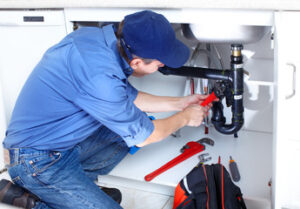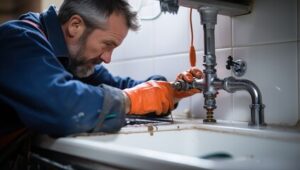The plumbing system in your home takes fresh water to all the fixtures and removes wastewater. Plumbers Lorain Ohio can help you avoid expensive plumber bills and make it easier to tackle simple DIY projects.
Whether you’re installing new pipes or fixing an existing one, this guide will help you understand the different types of home plumbing pipes.

Every home plumbing system has a water supply line that helps transfer fresh hot and cold water to essential household fixtures. Basic knowledge of this important element can help you detect problems, accurately describe them to contractors over the phone, and deal with emergencies competently.
The pipes that carry your fresh water supply are typically made from durable plastic or metal. They can be found throughout your property and are usually hidden inside walls and beneath floors. The type of piping that is used depends on what kind of plumbing system you have in your home. For specimen, PEX (cross-linked polyethylene) is a flexible pipe that can easily weave through walls and ceilings to reach different rooms in your house. It is also resistant to high levels of water pressure and is less likely to develop blockages. It’s a popular choice for many homeowners and plumbers.
Other common types of water supply piping include PVC, copper and galvanized steel. Each of these piping materials has its pros and cons. For example, PVC is a durable and inexpensive material that can withstand a great deal of water pressure, but it can crack or corrode over time. On the other hand, copper is a classic and reliable choice that offers better thermal conductivity and can last upwards of 50 years. However, it can be expensive to install.
Once fresh water enters your home via a main water line, it’s pumped under pressure through supply lines that lead to your water heater. This allows the water to heat up for your hot-water appliances and supply your faucets and showers.
From the water heater, hot and cold water lines are branched off to each fixture in your house. Some of these lines may even connect to your outdoor faucet so you can water your lawn and garden. Regardless of the specifics of your plumbing system, it’s crucial to have an air chamber in the main water supply line to prevent sudden turns off from creating several hundred pounds of pressure that can burst open pipes and fittings.
The water supply pipes carry fresh, clean drinking water to the fixtures and appliances in your home that use it. These include toilets, bathtubs, showers, sinks, and washing machines.
A main water line runs from a public municipal water source or a private well to your house and connects to a water meter. This pipe is typically large-diameter to handle the high volume of water needed for distribution. There is also a water shut-off valve located near the water meter that you can turn off to stop the flow of water to your house in case of an emergency.
Once the water enters your home, a series of smaller diameter plumbing pipes carry hot and cold water to each fixture. These pipes are typically made of copper, brass, or plastics. Galvanized steel pipes are sometimes found in older homes, and although they can be used as long as they are not exposed to direct sunlight or other sources of heat, it is generally recommended that you get them replaced with modern alternatives, as galvanized pipes corrode quickly.
Rigid copper piping is the most popular type of plumbing pipe in modern residential houses, and it can last for upwards of 50 years. It is valuable because it does not rust or leach chemicals into the water like some other pipe materials can. Another popular choice is PEX (cross-linked polyethylene), a durable and flexible plastic that is relatively inexpensive. This pipe has recently surpassed copper in popularity as it is easy to install and can be used for both hot and cold water lines.
A newer option is CPVC (chlorinated polyvinyl chloride), which offers the durability of PVC but has higher temperature ratings and improved fire resistance. ABS (acrylonitrile butadiene styrene) pipe is also sometimes used, but it can be noisy when pressure is applied and may not hold up to prolonged exposure to sunlight or harsh cleaning products. Flexible hoses, known as flex lines or braided hoses, are often used to make the final connection between your home’s water supply pipe and your actual plumbing fixtures like toilets and washing machines.
The drain plumbing system does two things: it removes water from fixtures and appliances and it disposes of wastewater. It’s important that it does both without contaminating your clean drinking water or letting sewage back into the house, since these would result in health problems and disgusting messes.
Your drainage pipes are typically made of PVC or ABS plastic (although older homes may have cast iron) and they’re located under your home’s foundation. Each fixture that drains has a pipe that connects to the main drainage line that exits your house and connects to either the septic tank or public sewer lines. Each fixture drain also has a “P trap” that is usually shaped like the letter P or U. This curved pipe holds water in the drain when it’s not in use, creating a seal that prevents waste odors from seeping into your house.
Each drain pipe has a vent that is sometimes located in the attic but is usually placed close to each trap to provide air circulation and prevent siphoning from clogging the drainage system. This venting system can also prevent foul odors from wafting up through the house’s ceilings.
Besides the water supply and drain pipes, your home has several other types of pipes that are used for ventilation, heating, cooling and so on. If you’re a homeowner and need to understand these other types of pipes, consult a professional plumber or your homeowner’s association for details.
It’s good to become familiar with your home plumbing systems, so you know what to do when trouble arises. While you’ll probably never need to replace your plumbing system or do major repairs, it’s a good idea to stay up-to-date on what your pipes are made of and how they work. That way, you can spot potential issues and take action to avoid costly repairs. Fortunately, with a little knowledge of your home’s pipes, you can keep your plumbing in great shape for decades to come. And who knows — with the right plumbing maintenance, you may even be able to avoid any plumbing emergencies in the future!
A home’s plumbing system is not just about the water it carries. It also has to deal with the waste that is produced by household fixtures like sinks, baths, showers, and toilets. A system known as a drain-waste-vent or DWV is used to convey this waste to a city sewer, septic tank, or – in rural areas – a leach field.
As its name suggests, a DWV system is designed to allow air to enter the pipe network to prevent a vacuum from being created that would result in the sewage being trapped inside the pipes. This is a key safety feature, as sewage is a highly toxic substance that can be incredibly dangerous to human health if it builds up within the house. In order to maintain proper air pressure in the system, the sewage and waste pipes are vented either through a roof vent (external) or through an internal vent running up the wall behind the toilet.
The main difference between a waste system and a normal drainage system is that the former is specifically designed to carry the wastewater from a property’s sinks, tubs, showers, and washing machines away to the main drain system. As a result, the pipes in a waste system are generally larger in diameter than standard water pipes to accommodate this additional load.
There are many different types of waste line piping available on the market, but Poly Vinyl Chloride (PVC) is often the most common. PVC is a lightweight, durable, and easy to work with material that’s resistant to chemicals, heat, and other environmental factors. It’s also an inexpensive option, making it a popular choice for plumbers to use when installing new plumbing in the home.
As with the other types of pipe, there are many fittings that can be used to create a comprehensive waste pipe network. These include couplings, tees, and bends. Available in a variety of sizes to cater for the different fixtures in a home, these fittings are typically connected using solvent weld or push fit technology. The latter makes installation much quicker and easier as there are no tools required to make the connections.



